7 Best Tools for Pruning - Commonly Used for Your Garden
Written by Ivy
Dec 29 2022
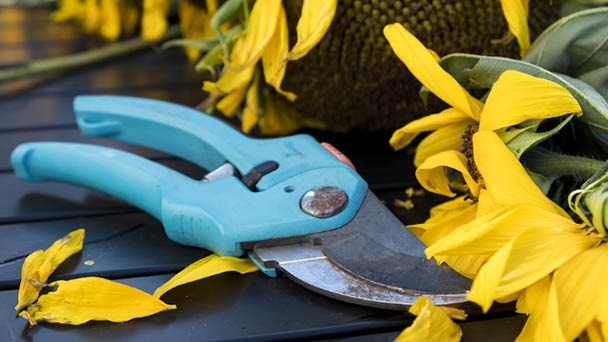
Pruning is a fantastic way to encourage tree health and growth while maintaining the aesthetic appeal of your landscape. But the appropriate tools and equipment are needed for successful tree pruning and trimming. Knowing what equipment a professional arborist uses will help you choose what you need and preserve the health of your trees.
- Secateurs
- Pruning Saw
- Long-Reach Pruner
- Loppers
- Hand Shears
- Topiary Shears
- Pole Pruner
1. Secateurs
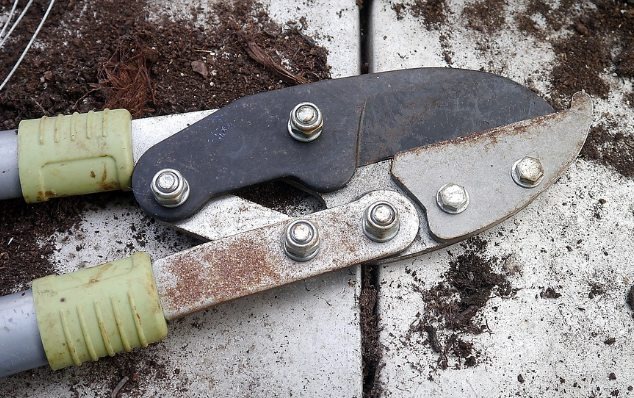
Secateurs are a straightforward hand-held tool perfect for snipping delicate plants and removing thicker branches or dead stems to promote a tidy appearance and healthy growth. Even though a good pair of secateurs with a steel blade can prune and trim plants or bushes, the features of each model vary slightly.
The three different types of secateurs—bypass secateurs, anvil secateurs, and ratchet secateurs—all have essentially the same features but only exist to make clean cuts for efficient pruning.
Because of their adaptable design, bypass secateurs are ideal for regular use because they can cleanly cut through live plants or a variety of shrubbery without causing any harm. Anvil secateurs, on the other hand, are excellent for tougher jobs like trimming thicker branches and deadwood.
For people with arthritis or other conditions that make using standard secateurs difficult, ratchet secateurs are extremely useful. In a few steps, you can use them to quickly cut through dense bushes or deadwood.
Each type's average price ranges from $13 to $150. However, if it is from companies like Niwaki, the cost may exceed $150.
There is a reason why secateurs are a popular choice among novice gardeners. One of the many benefits of secateurs is its broad range of applications, which makes it ideal for both thin branches and flower heads. Secateurs' lightweight construction and ergonomic handle make them comfortable to use. Eden advises purchasing a good pair of secateurs with blades that are flexible, rust-resistant, and require little maintenance.
You should be aware of the disadvantages that each type of secateurs carries before purchasing the right ones. While bypass secateurs enable precise cutting, they are not the best tool for handling large or challenging branches. For tougher and larger branches, anvil secateurs may be a better choice, but they also allow for less accuracy. Meanwhile, with a pair of ratchet secateurs, you may need some time to get used to this tool.
2. Pruning Saw
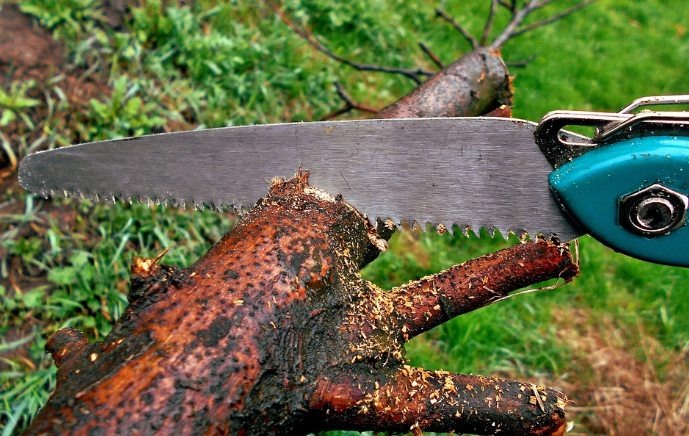
For the purpose of creating a well-kept landscape, pruning saws are made specifically for the job of sawing through extra tree branches.
An accessible approach to trimming small branches and shrubs is made possible by the pruning saw's ergonomic handle and razor-sharp teeth. However, there are various types of pruning saws on the market, each type designed for a specific kind of branch or stem.
For the maintenance of your landscape, pruning saws are necessary to cut away thicker branches. Pruning saws come in a variety of styles with various blade types and configurations, which, among other things, affects how much they cost. Given its size and intended use, the price, which starts at $10, can, however, exceed $4000.
You have the option to select from a variety of options, depending on your needs, such as hand-held pruning saws, curved blade pruning saws, pole pruning saws, or electric saws, because pruning saws come in a variety of designs and types. These pruning implements are sturdy and reliable enough to cut thicker and more extensive branches.
As for the drawback, a pruning saw is one of the most delicate yet durable tree-pruning tools, making it perfect for professional use. Pruning saws are prone to slipping and accidentally damaging wood, which is typically a risk factor for non-horizontal branches.
Eden advises hiring landscapers who have the necessary expertise to handle and use a pruning saw effectively.
3. Long-Reach Pruner
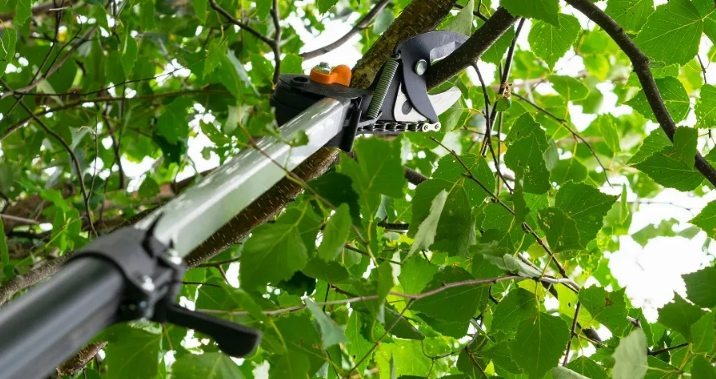
The long-reach pruner is another tool for pruning trees that is great for cutting back on extra branches. For the occasional pruning of tall trees, this pruning tool has a long pole and is attached with bypass secateurs. A long-reach pruner makes it simple to trim tree branches at a height that typically calls for a ladder.
However, a long-reach pruner is not just the ideal pruning tool for trees. Additionally, it is fantastic for pruning the interior of a large plant or bush without bending or stooping. The long shaft enables you to prune at a right angle and even reach over a fence line.
These long-reach pruning tools have a grip at one end that you can use to access the prune shears at the opposite end of the long shaft. In order to quickly prune the branches or young trees, you must use your grip and reach wherever you want to.
Long-reach pruners may also be found; their costs can range from $40 to $170 and they may have a different type of pruning shear on the other end or let you change the height of the pole.
Because they are lightweight and simple to handle, long-reach pruners have the best benefit of allowing access to smaller or higher branches from the ground up. Since you will be at ground level, you are largely protected from any ants or thorns that may be present up there.
The long-reach pruner is ideal for landscaping because it has a cut and hold system, but you should take safety measures, such as wearing goggles or hats while pruning, to protect your eyes. Choose one based on your needs as they come with different cutting edges. Additionally, the shaft may not be as strong as you believe it to be given the height of the tree you want to prune.
4. Loppers
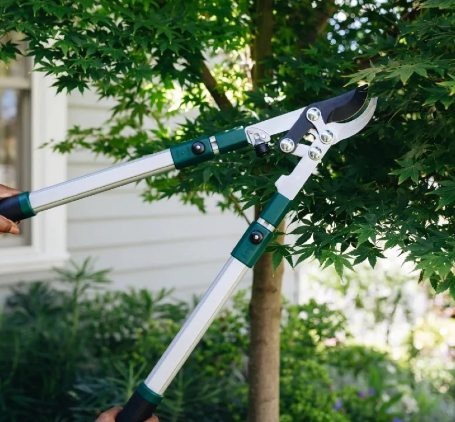
One of the best hand-held garden tools for pruning thicker branches up to 2 or 3 inches is a lopper. Due to its capacity to provide greater reach and cutting power, the lopper is preferred over other pruning shears.
The extended handles and grip make it simple to cut or prune even the trickiest branches. The grips have padding made of rubber or foam to prevent slippage and other accidents like blisters.
Loppers, like other pruning tools, have a variety of uses depending on their size, weight, cutting action, and blade material. These characteristics also have an impact on a lopper's price range. Nevertheless, the typical price can range from $15 to $280.
The main mechanical benefit of having a lopper is the ability to prune any thick branch up to 3 inches. For yard work, they make a great pair of grips. However, loppers made of carbon steel need to be kept dry because moisture will cause them to rust. On the other hand, stainless steel is susceptible to aging and becoming dull.
5. Hand Shears
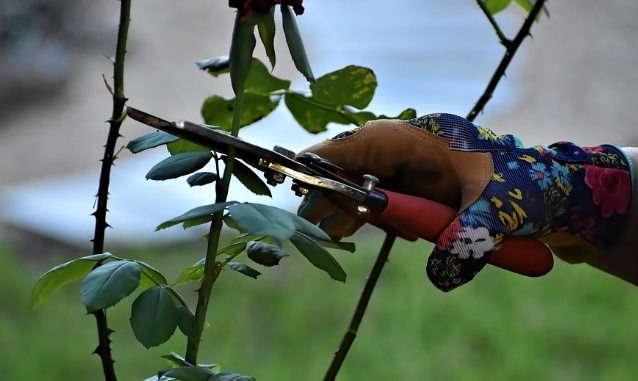
Hand shears are robust scissors made specifically for high-quality commercial craftsmanship. The most effective hand shears for gardens and yards are always fitted with a superb cutting system. For trimming hedges and bushes, it should be ideal because it makes it easier to cut larger branches.
A hand shear or hedge shear may appear to be a straightforward tool, but high-quality materials can increase the cost of this garden pruning tool. The range of costs, which can be between $19 and $90, is quite reasonable.
A hand shear's advantages include its cutting mechanism, cutting capacity, ease of use, and even price range. A hand shear may take a while to give you precise accuracy and perfect cuts when cutting thicker vegetation, such as thicker limbs and vines.
6. Topiary Shears
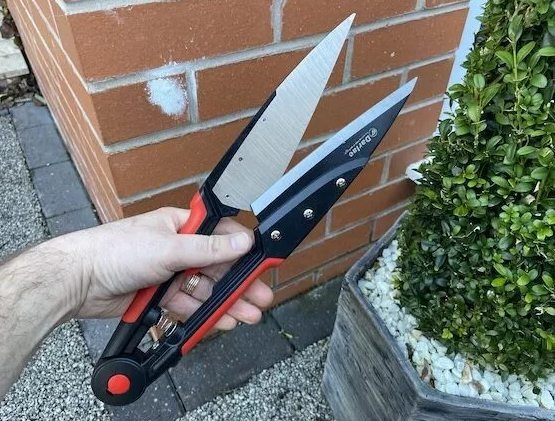
One hand can easily operate a topiary shear, a hand-held gardening tool. It is one of the most basic pruning tools used to shape perennial plants, soft shoots, and unwanted twigs on young trees or plants in your yard or landscape.
Shears for topiaries, also called sheep shears, are made to cut precisely on small, delicate plants. A topiary shear can cost anywhere between $11 and $100, depending on the material quality and type of blade used.
When it comes to topiary shears, the curved blades, ergonomic handle design, and anti-jarring technology make a solid list of benefits. But once more, this garden tool for pruning has its limitations.
7. Pole Pruner
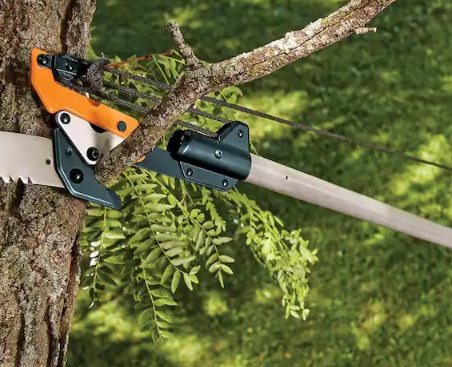
The pole pruner is one of the most well-known extending telescopic pruning tools that enables you to reach greater heights. More access can be provided to longer lengths by a pole pruner than by any powered pruning tool. A skilled pole pruner has a reach of up to 21 feet, so you can prune and shape the trees as you see fit.
A pair of secateurs are attached to one end of the pole of the pole pruner, and they function in conjunction with a string to provide an excellent cutting mechanism. You can control the blade that moves up and down with the string by pulling it down. This causes the blade to cut the undesirable branches at a height.
It is important to note that a manual pole pruner is portable and simple to use from the ground up. You can reach great heights without using a ladder thanks to its effective cutting mechanism.
The cutting mechanism, however, is dependent upon the sturdy string being correctly strung and the telescoping function working as intended. You might be left with nothing more than a long pole if any of the features fail.
Which Tools Are Best for Pruning?
According to the factors we listed above, each pruning tool has advantages and disadvantages of its own and is suitable for a particular type of cut. Here is a rough outline of what the different pruning tools are used for:
-
Pruning shears: for pruning branches up to 2.5–3 cm in diameter.
-
Lopper: for pruning branches up to 4–5 cm.
-
Pruning saw: for pruning branches up to 10 cm thick.
-
Telescopic pruning shears: similar to pruning shears, but useful for pruning tall or distant branches without a stepladder (the shaft can be extended up to 3.5–4 m in length).
-
Telescopic pole saw: for pruning tall or distant branches without a stepladder (the pole can be extended to over 4 m).
-
Chainsaw: for pruning branches over 10 cm in diameter (depending on the power rating and power supply).
-
Telescopic pruner: similar to a chainsaw on a pole, for pruning tall or distant branches without a stepladder (the pole can be extended to over 3 m).
-
Brushcutter: for cutting reeds, brambles, shrubs, saplings and groups of suckers, including of large diameter.
-
Hedgetrimmer: for trimming hedges and shrubs (also available with telescopic shaft).
When pruning, we recommend that you always wear the most appropriate protective clothing: face shield or protective spectacles, work jacket and trousers, utility gloves, safety shoes and, when using very noisy tools, noise filtering ear defenders or ear plugs. Whenever using a chainsaw or telescopic pruner, wear cut-resistant clothing, gloves, and shoes. Wear a protective helmet as well if falling branches, pieces of wood, or other objects could hurt you. By the way, here you will find some rules for safely using a chainsaw (both battery-powered and other types).
Regardless of the equipment, the best times to prune are winter and the first months of summer. At different times of year you get different results, because the plants' response to cutting changes: find out more about when and why it is better to prune in winter.
We mentioned that knowledge and expertise are necessary to prune properly. In short, it takes experience or specific training, like that needed to become a professional pruner.
Reasons for Tree Pruning
Before choosing to prune branches, it is crucial to locate problematic areas within the tree's structure. Removing dead branches, increasing light and air exposure, controlling the production of flowers or fruits, and providing adequate clearance are a few of the most popular reasons for pruning.
Dead Branch Removal
Dead or decaying tree branches must be cut down for your safety in order to reduce the possibility of limbs falling. A tree's overall appearance will be enhanced as an added benefit of removing dead branches. The dry exterior and brown interior of dead branches make them easy to spot. In addition to reducing the chance of pests and diseases invading the tree's structure, pruning these away helps direct nutrients to healthy tree branches.
Increased Light and Air Exposure
Pruning a mature tree thins it out by removing old branches, creating space for direct sunlight and airflow to hit developing foliage. The distinctive crown shape of a tree is particularly dependent on sunlight. A tree is more susceptible to external stressors when old branches obstruct air and sunlight, which can harm the tree's general health and shape.
Improved Fruit Or Flower Production
Pruning is crucial to preserving the yield, bloom, and fruit quality of any fruit trees or flowering shrubs that are abundant in your lawn. A tree's size can be managed through pruning, which also ensures that growing branches receive the right nutrients. Pruning also makes it simple for you to reach ripe fruit if you need to harvest it from your trees.
Proper Clearance
Pruning can help make sure there is space between the tree and your roof, power lines, or other vulnerable areas if your branches are encroaching on your home or the area around it. To prevent electrical hazards, harm to your home's exterior, and potential debris during storms, it's crucial to keep the appropriate distance between your home and neighboring structures.
How to Prune a Tree
The pruning procedure should be followed even though cutting limbs may seem straightforward to maintain the health of the tree. Moreover, by taking these precautions when removing large branches, you will reduce your risk. The ideal pruning procedure is to follow these steps.
- Cut the branch's underside. Start your cut about a foot and a half from the branch's base on the underside. Cutting angles for pruning should be 45 degrees or more. Stop sawing once you've cut halfway through.
- Make your way to the top of the branch. The branch will eventually break free if you start about an inch further from your initial cut. Again, the second cut should be at a 45-degree angle to prevent water from gathering and harboring dangerous diseases.
- locate the branch collar on the trunk. When you've finished, follow the stub down until you come across a small swelling that is covered in grippy bark. This is the branch collar, and to promote proper healing it should be cut at a 45-degree angle.
Warnings
Tree pruning is a difficult task that should only be attempted by those who are willing to climb a ladder, use saws or shears, and determine which branches need maintenance. Here are some warnings you should consider before taking on pruning by yourself:
- To protect yourself from falling debris, put on the proper protective gear, such as gloves and safety glasses.
- When a tree is growing, which is between spring and late summer, avoid pruning. Overzealous pruning can eliminate the leaves that provide the tree with the nutrients it needs.
- Use only sharp tools, please. Sharp saws and pruning shears can rip the bark dangerously and expose the tree to pests.
- Examine the branch for any indications of bee, wasp, or other animal dangers.
- Keep from removing your tree's entire top. This throws the balance off and makes it more likely to fall.
Professional Tree Pruning
It might be wise to seek professional assistance if you are unsure of where to prune your tree or if you need to trim a branch that is close to a vulnerable area, such as a powerline or roof. Additionally, this is a good choice for homeowners who would rather not take the chance of caring for large or mature trees. Professional tree services have the tools and expertise needed to perform the necessary maintenance on your trees without causing harm to your house or the area around it.
Our Conclusion
Maintaining a healthy and aesthetically pleasing landscape requires regular tree pruning. To avoid long-term structural damage and promote healthy growth, it's critical to keep up with tree maintenance. Make sure to regularly finish the pruning process to prevent falling limbs from harming power lines, the tree's new growth, and you.
But if you believe a task is beyond your scope of knowledge, we advise getting in touch with a landscaping expert like SavATree. Their network of qualified arborists is equipped to handle a range of tree, shrub, and lawn care requirements, such as pruning, weeding, tree removal, and more. Routine tree maintenance can be made easier and less dangerous by hiring a pro for pruning.
Latest Updated
- Benefits of Bugleweed - 7 Science-backed Health Benefits
- Bugleweed Dangers & Side Effects - Is It Poisonous?
- How to Plant Evergreen Trees - What You Should Know
- When to Plant Evergreens - Grow Guide for Evergreen Trees
- 12 Wonderful Evergreen Shrubs for Your Garden
- 12 Popular Evergreen Plants with Pictures for Beginners
- When And How To Prune A Lilac Bush Like a Pro
- How to Grow & Care for Lilac Vine (Hardenbergia Violacea)
- Japanese Lilac Tree (Syringa Reticulata) Care & Propagation Guide
- Shumard Oak Pros and Cons - What to Know
Popular Articles
- Winter maintenance of Antirrhinum Majus
- How to Grow Terminalia Mantaly Tree
- How to Grow and Care for Crossostephium Chinense
- How to grow Antirrhinum Majus in spring
- Peristeria Elata (Dove Orchid) Profile: Info & Care Guide
- Underwatered Snake Plant (Sansevieria Trifasciata) - Signs And How To Fix
- How to Care for Brazilian Jasmine Plant (Mandevilla Sanderi)
- How to Grow & Care for Graptopetalum Purple Delight in Summer
- Rosa Chinensis (China Rose): Plant Growing & Care Tips
- How to Care for Baby Sun Rose (Aptenia Cordifolia)